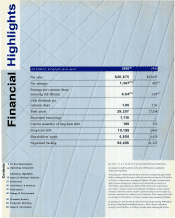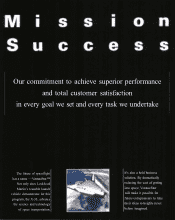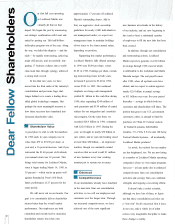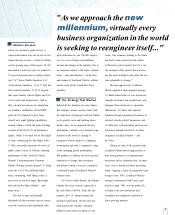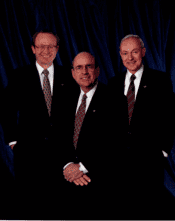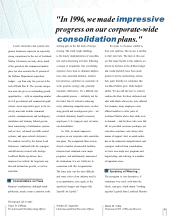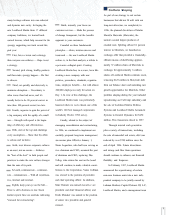Lockheed Martin 1996 Annual Report Download - page 4
Download and view the complete annual report
Please find page 4 of the 1996 Lockheed Martin annual report below. You can navigate through the pages in the report by either clicking on the pages listed below, or by using the keyword search tool below to find specific information within the annual report.
O
ur first full year operating
as Lockheed Martin was
virtually all that we had
hoped. We began the year by announcing
our strategic combination with Loral and
ended by posting our 13th half-billion-
dollar-plus program win of the year. Along
the way, we defied the skeptics — and the
odds — by rapidly restructuring, achieving
major efficiencies, and successfully inte-
grating 17 business cultures into a world-
class team that, through synergy, achieved
a strong track record.
In less than two years, we have
moved into the front ranks of the industry's
consolidation and put some huge chal-
lenges behind us to create a leading diver-
sified global technology company. But
perhaps the most meaningful measure is
how these successes have translated into
increased shareholder value.
Shareholder Value
A good place to start is with the numbers:
In 1996 stock in your company rose in
value from $79 to $91.50 per share, at
year end, a 16 percent increase. And if you
reinvested the $1.60 payout of dividends,
your annual return was 18 percent. This
brings total returns for Lockheed Martin,
since it began trading March 16, 1995, to
39 percent — which stacks up pretty well
against Standard & Poor's 500 Stock
Index performance of 27 percent for the
same period.
We will never rest on our laurels. Our
goal is to consistently deliver shareholder
returns better than the overall market
performance. Our employees are both
committed and incentivized to maximize
shareholder returns since they own
approximately 17 percent of Lockheed
Martin's outstanding shares. Add to
that, our aggressive stock ownership
guidelines for nearly 2,000 individuals in
our management ranks; we expect our
management team to maintain holdings
of two times to five times annual salary,
depending on position.
Supporting this market performance,
Lockheed Martin's fully diluted earnings
in 1996 were $6.04 per share, versus
$3.05 in 1995. Earnings per share, exclud-
ing nonrecurring items in both years,
increased 8 percent to $5.40 in 1996,
versus $5.01 in 1995. Our continued
emphasis on strong cash management
yielded $1 billion in free cash flow during
1996, after expending $244 million of
cash payments and $150 million of capital
outlays for our integration and consolida-
tion program. On the sales front, we
recorded $26.9 billion in 1996, compared
with $22.9 billion in 1995. During the
year, we brought in nearly $30 billion in
new orders, and at year end, backlog stood
at more than $50 billion — an impressive
number, though we constantly remind
ourselves that we need to add $1 million
of new business every four working
minutes just to sustain our revenues.
Enhanced
Competitiveness
If our shareholders already have benefited
in the near-term from our consolidation
activities, so too will our employees and
customers over the longer term. Through
our increased competitiveness, we have
achieved one of the most significant
new business win-streaks in the history
of our industry, and are now beginning to
hire (and re-hire) a substantial number
of employees to fill the new jobs that have
been created.
In addition, through our consolidation
and restructuring actions, Lockheed
Martin expects to generate over $6 billion
in savings through 1999, most of which
is attributable to the Lockheed and Martin
Marietta merger. The real payoff comes
after 1999, when all up-front costs have
abated, and we expect to sustain approxi-
mately $2.6 billion in annual savings
or $13 billion over every five-year period
thereafter — savings in which both our
customers and shareholders will share. The
portion that goes to our U.S. government
customers, alone, is enough to fund the
purchase of 2 Titan IV Centaur rockets,
10 Trident II missiles, 800 Hellfire
missiles, 3 C-130Js, 8 F-16s and 100 Army
Tactical Missile Systems... all incidentally,
Lockheed Martin products!
As noted, the outlook for our employ-
ees has brightened, too. We are now hiring
at a number of Lockheed Martin operating
companies where we won major programs
last year — at least partly due to enhanced
competitiveness from our consolidation
activities and synergy from our combined
strengths and ongoing cost-cutting efforts.
It doesn't take a rocket scientist,
although we have lots of them, to figure
out that these consolidation activities are
a "win-win" for all concerned. But it does,
in our case, take a whole lot of talent
across every imaginable discipline to make
these changes a reality.
Dear Fellow Shareholders


